 W
WAlpharts Tod is an anonymous late medieval Middle High German poem in the poetic cycle of the hero Dietrich von Bern, the legendary counterpart of the historical Ostrogothic king Theodoric the Great. It is part of the so-called "historical" Dietrich material. It may have written as early as between 1245 and 1300, but it is only transmitted in a single manuscript from around 1470 or 1480. The place of composition is unknown.
 W
WThe Ambraser Heldenbuch is a 16th-century manuscript written in Early New High German, now held in the Austrian National Library. It contains a collection of 25 Middle High German courtly and heroic narratives along with some shorter works, all dating from the 12th and 13th centuries. For many of the texts it is the sole surviving source, which makes the manuscript highly significant for the history of German literature. The manuscript also attests to an enduring taste for the poetry of the MHG classical period among the upper classes.
 W
WThe Annolied is an Early Middle High German poem in praise of Archbishop Anno II of Cologne. Anno died in 1075 and the poem, probably written in the years immediately after his death, can be seen as part of a campaign for his canonisation, which was finally achieved in 1183.
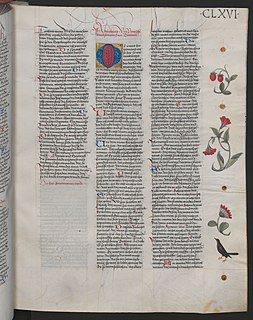 W
WBiterolf und Dietleib is an anonymous Middle High German heroic poem concerning the heroes Biterolf of Toledo and his son Dietleib of Styria. It tells the tale of Biterolf and Dietleib's service at the court of Etzel, king of the Huns, in the course of which the heroes defeat Etzel's enemies, including an extended war/tournament against the Burgundian heroes of the Nibelungenlied. As a reward for their services, Dietleib and Biterolf receive the March of Styria as a fief. The text is characterized by its comedic parody of the traditions of heroic epic.
 W
WBligger von Steinach was the name of a series of feudal lords of Steinach, today Neckarsteinach in Hesse, Germany. Collectively the noble family was known as the Edelfreien von Steinach. The family was influential, having close connections to the Holy Roman Emperor and to the Bishopric of Worms. The family held Steinach in fief to Worms.
 W
WDer Busant, also known as Der Bussard, is a Middle High German verse narrative, containing 1074 lines of rhyming couplets. The story tells of a love affair between the Princess of France and the Prince of England, who elope but are separated after a buzzard steals one of the princess's rings. After more than a year of separation, with the prince having gone mad and living as a wild man, they are reunited.
 W
WThe Codex Manesse, Manesse Codex, or Große Heidelberger Liederhandschrift is a Liederhandschrift, the single most comprehensive source of Middle High German Minnesang poetry, written and illustrated between c. 1304 when the main part was completed, and c. 1340 with the addenda.
 W
WDietrichs Flucht or Das Buch von Bern is an anonymous 13th-century Middle High German poem about the legendary hero Dietrich von Bern, the legendary counterpart of the historical Ostrogothic king Theodoric the Great. It is part of the so-called "historical" Dietrich material and is closely related to, and always transmitted together with, a second Dietrich poem, the Rabenschlacht. A Heinrich der Vogler is named as author in an excursus of the poem. Earlier scholarship considered him to be the author of Dietrichs Flucht and possibly also of the Rabenschlacht, however more recent scholarship believes he is only author of this excursus.
 W
WDas Eckenlied or Ecken Ausfahrt is an anonymous 13th-century Middle High German poem about the legendary hero Dietrich von Bern, the legendary counterpart of the historical Ostrogothic king Theodoric the Great. It is one of the so-called fantastical (aventiurehaft) Dietrich poems, so called because it more closely resembles a courtly romance than a heroic epic.
 W
WErec is a Middle High German poem written in rhyming couplets by Hartmann von Aue. It is thought to be the earliest of Hartmann's narrative works and dates from around 1185. An adaptation of Chrétien de Troyes' Erec et Enide, it is the first Arthurian Romance in German.
 W
WGoldemar is a fragmentary thirteenth-century Middle High German poem by Albrecht von Kemenaten about the legendary hero Dietrich von Bern, the legendary counterpart of the historical Ostrogothic king Theodoric the Great. It is one of the so-called fantastical (aventiurehaft) Dietrich poems, so called because it more closely resembles a courtly romance than a heroic epic.
 W
WHartmann von Aue, also known as Hartmann von Ouwe, was a German knight and poet. With his works including Erec, Iwein, Gregorius, and Der arme Heinrich, he introduced the courtly romance into German literature and, with Wolfram von Eschenbach and Gottfried von Strassburg, was one of the three great epic poets of Middle High German literature.
 W
WIwein is a Middle High German verse romance by the poet Hartmann von Aue, written around 1203. An Arthurian tale freely adapted from Chrétien de Troyes' Old French Yvain, the Knight of the Lion, it tells the story of Iwein (Yvain), a knight of King Arthur's Round Table. It was written after Hartmann's Erec, and may have been his last work.
 W
WJans der Enikel, or Jansen Enikel, was a Viennese poet and historian of the late 13th century. He calls himself "Jans, the grandson of Jans", and claims to be a citizen of Vienna with full patrician rights. In Viennese council records he appears as "Jans der Schreiber", so it is likely he was secretary to the council (Stadtschreiber). He wrote a Weltchronik and a Fürstenbuch, both in Middle High German verse.
 W
WThe Jenaer Liederhandschrift is a 14th-century manuscript containing lyrics and melodies to songs in Middle High German. The majority of the lyrics belong to the genre of Spruchdichtung and, with 91 melodies, the manuscript is the single most important source for the music of this genre.
 W
WThe Jüngeres Hildebrandslied or Das Lied von dem alten Hildebrand is an anonymous Early New High German heroic ballad, first attested in the fifteenth century. The ballad features the same basic story as the much older Hildebrandslied, but was composed without knowledge of that text. Rather, it reworks the oral legend of the warrior Hildebrand and his fight against his son in accordance with late medieval and early modern taste. It is highly sentimentalized and focuses on Hildebrand's return home rather than the tragic conflict of the older tradition.
 W
WThe Kaiserchronik is a 12th-century chronicle written in 17,283 lines of Middle High German verse. It runs from Julius Caesar to Conrad III, and seeks to give a complete account of the history of Roman and German emperors and kings, based on a historiographical view of the continuity of the Roman and German successions. The overall pattern is of a progression from pagan to Christian worlds, and theological disputations stand at the turning-points of the Christianization of the Empire. However, much of the material is legendary and fantastic, suggesting that large sections are compiled from earlier works, mostly shorter biographies and saints' lives.
 W
WThe Kleine Heidelberger Liederhandschift is a collection of Middle High German Minnesang texts. In Minnesang scholarship it is referred to as MS. A. It is held by the Heidelberg University Library with the signature Cod.Pal.germ. 357.
 W
WKonrad von Ammenhausen was a Swiss Benedictine monk and priest at Stein am Rhein. He is primarily known for his Schachzabelbuch, a Middle High German verse translation of the Liber de moribus hominum et officiis nobilum ac popularium super ludo scacchorum by Jacobus de Cessolis, completed in 1337. The work survives in more than 20 manuscripts and was frequently printed in the 16th century.
 W
WKudrun, is an anonymous Middle High German heroic epic. The poem was likely composed in either Austria or Bavaria around 1250. It tells the story of three generations of the ruling house of Hetelings on the North Sea, but is primarily the story of Kudrun, who is abducted by the Norman prince Hartmut who desires to marry her. Kudrun remains true to her fiancé Herwig and eventually is rescued. After the defeat of the Normans, however, Kudrun ensures that peace will be kept between the two peoples by arranging for marriages and alliances.
 W
WLanzelet is a medieval romance written by Ulrich von Zatzikhoven after 1194. It is the first treatment of the Lancelot tradition in German, and contains the earliest known account of the hero's childhood with the Lady of the Lake-like figure in any language. The poem consists of about 9,400 lines arranged in 4-stressed Middle High German couplets. It survives complete in two manuscripts and in fragmentary form in three others.
 W
WLaurin or Der kleine Rosengarten is an anonymous Middle High German poem about the legendary hero Dietrich von Bern, the legendary counterpart of the historical Ostrogothic king Theodoric the Great. It is one of the so-called fantastical (aventiurehaft) Dietrich poems, so called because it more closely resembles a courtly romance than a heroic epic. It likely originates from the region of South Tyrol, possibly as early as 1230, though all manuscripts are later.
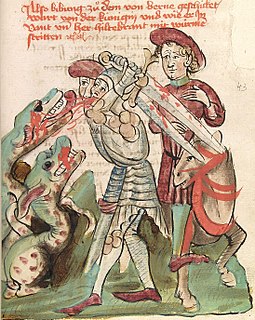 W
WIn legends about Theodoric the Great that spread after his death, the Gothic king Theodoric became known as Dietrich von Bern, a king ruling from Verona (Bern) who was forced into exile with the Huns. The differences between the known life of Theodoric and the picture of Dietrich in the surviving legends are usually attributed to a long-standing oral tradition that continued into the sixteenth century. The majority of legendary material about Dietrich/Theodoric comes from high and late medieval Holy Roman Empire and is composed in Middle High German or Early New High German. Another important source for legends about Dietrich is the Old Norse Thidrekssaga, which was written using German sources. In addition to the legends detailing events that may reflect the historical Theodoric's life in some fashion, many of the legends tell of Dietrich's battles against dwarfs, dragons, giants, and other mythical beings, as well as other heroes such as Siegfried. Dietrich also appears as a supporting character in other heroic poems such as the Nibelungenlied, and is frequently referenced and alluded to throughout medieval German literature.
 W
WDas Lied vom Hürnen Seyfrid, or Hürnen Seyfrid for short, is an anonymous Early New High German heroic ballad. The poem concerns the adventures of young Siegfried, hero of the Nibelungenlied. It preserves traditions about Siegfried that are otherwise only known from Old Norse sources and thus attest their existence in oral traditions about Siegfried that circulated outside of the Nibelungenlied in Germany.
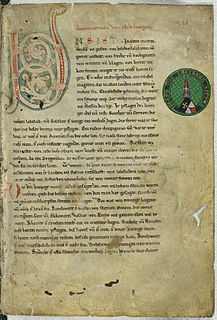 W
WThe Nibelungenlied, translated as The Song of the Nibelungs, is an epic poem written around 1200 in Middle High German. Its anonymous poet was likely from the region of Passau. The Nibelungenlied is based on an oral tradition that has some of its origin in historic events and individuals of the 5th and 6th centuries and that spread throughout almost all of Germanic-speaking Europe. Parallels to the German poem from Scandinavia are found especially in the heroic lays of the Poetic Edda and in the Völsunga saga.
 W
WOrtnit is the eponymous protagonist of the Middle High German heroic epic Ortnit. First written down in strophic form in around 1230 by an anonymous author, it circulated in a number of distinct versions.
 W
WOswald von Wolkenstein was a poet, composer and diplomat. In his diplomatic capacity, he traveled through much of Europe to as far as Georgia.
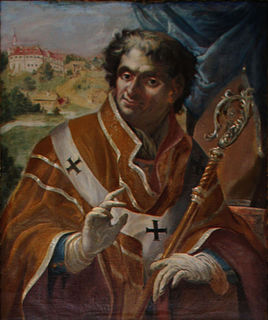 W
WOtto II, sometimes called Otto von Berg, was the 24th Bishop of Freising from 1184 and, like his predecessor, Otto I, a supporter of the Hohenstaufen monarchs. Around 1200, he composed the "Laubacher Barlaam", a Middle High German translation of a 12th-century Middle Latin version of the legend of Barlaam and Josaphat. His version is not to be confused with the verse romance Barlaam und Josaphat (c.1220) of Rudolf von Ems.
 W
WOtto IV, Margrave of Brandenburg-Stendal, nicknamed Otto with the arrow was the Margrave of Brandenburg from the House of Ascania from 1266 until his death.
 W
WParzival is a medieval romance by the knight-poet Wolfram von Eschenbach in Middle High German. The poem, commonly dated to the first quarter of the 13th century, centers on the Arthurian hero Parzival and his long quest for the Holy Grail following his initial failure to achieve it.
 W
WDie Rabenschlacht is an anonymous 13th-century Middle High German poem about the hero Dietrich von Bern, the legendary counterpart of the historical Ostrogothic king Theodoric the Great. It is part of the so-called "historical" Dietrich material and is closely related to, and always transmitted together with, a second Dietrich poem, Dietrichs Flucht. At one time, both poems were thought to have the same author, possibly a certain Heinrich der Vogler, but stylistic differences have led more recent scholarship to abandon this idea.
 W
WDer Rosengarten zu Worms, sometimes called Der große Rosengarten to differentiate it from Der kleine Rosengarten (Laurin), and often simply called the Rosengarten, is an anonymous thirteenth-century Middle High German heroic poem in the cycle of Dietrich von Bern. The Rosengarten may have been written as early as before 1250, but is securely attested by around 1300. It is unclear where it was written.
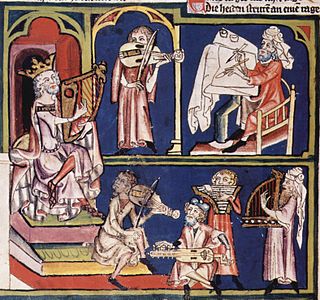 W
WRudolf von Ems, also called in English Rudolf of Ems, was a medieval Austrian epic poet.
 W
WMeister Rumelant or Rumslant was a Middle High German lyric poet. His origin is uncertain, although in his poems he referred to himself as a "Saxon". His name suggests the life of a touring minstrel.
 W
WThe Sachsenspiegel is the most important law book and custumal of the Holy Roman Empire. Originating between 1220 and 1235 as a record of existing customary law, it was used in places until as late as 1900. It is important not only for its lasting effect on later German law but also as an early example of written prose in a German language. The Sachsenspiegel is the first comprehensive law book not in Latin, but in Middle Low German language. A Latin edition is known to have existed, but only fragmented chapters remain.
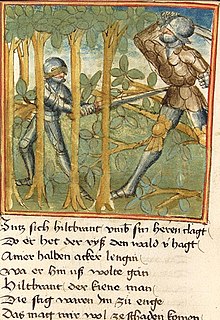 W
WSigenot is an anonymous Middle High German poem about the legendary hero Dietrich von Bern, the legendary counterpart of the historical Ostrogothic king Theodoric the Great. It is one of the so-called fantastical (aventiurehaft) Dietrich poems, so called because it more closely resembles a courtly romance than a heroic epic. It was likely written in the Alemannic dialect area, no later than 1300.
 W
WSpruchdichtung or Sangspruchdichtung is the German term for a genre of Middle High German sung verse. An individual work in this genre is called a Spruch, literally a "saying", and may consist of one or more strophes.
 W
WTannhäuser was a German Minnesinger and poet. Historically, his biography is obscure beyond the poetry, which dates between 1245 and 1265.
 W
WUlrich von Türheim was a German writer from the Augsburg area writing during the first half of the 13th century. Three of his works have survived: a conclusion to the version of the Tristan legend left unfinished by Gottfried von Strassburg; Rennewart, a continuation of Willehalm, left unfinished by Wolfram von Eschenbach; and fragments of a version of Cligès based on that of Chrétien de Troyes. It is not known whether this last work was a separate work or also a continuation, in this case of a now lost Cligès by Konrad Fleck. The relative chronology of these works is disputed, though Rennewart is generally regarded as the last.
 W
WVirginal, also known as Dietrichs erste Ausfahrt, or Dietrich und seine Gesellen is an anonymous Middle High German poem about the legendary hero Dietrich von Bern, the legendary counterpart of the historical Ostrogothic king Theodoric the Great. It is one of the so-called fantastical (aventiurehaft) Dietrich poems, so called because it more closely resembles a courtly romance than a heroic epic. The poem was composed by 1300 at the latest, and may have been composed as early as the second quarter of the thirteenth century.
 W
WWalther von der Vogelweide was a Minnesänger, who composed and performed love-songs and political songs ("Sprüche") in Middle High German. Walther has been described as greatest German lyrical poet before Goethe; his hundred or so love-songs are widely regarded as the pinnacle of Minnesang, the medieval German love lyric, and his innovations breathed new life into the tradition of courtly love. He is also the first political poet writing in German, with a considerable body of encomium, satire, invective, and moralising.
 W
WThe Weingarten Manuscript is a 14th-century illuminated manuscript containing a collection of Minnesang lyrics. It is currently in the Württembergische Landesbibliothek, Stuttgart, with the shelf-mark HB XIII 1. In Minnesang scholarship it is referred to as Manuscript B.
 W
WWolfdietrich is the eponymous protagonist of the Middle High German heroic epic Wolfdietrich. First written down in strophic form in around 1230 by an anonymous author, it survives in four main versions, widely differing in scope and content, and largely independent of each other.
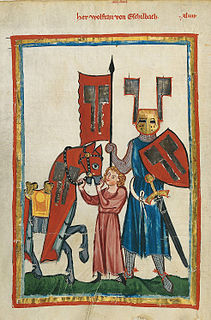 W
WWolfram von Eschenbach was a German knight, poet and composer, regarded as one of the greatest epic poets of medieval German literature. As a Minnesinger, he also wrote lyric poetry.
 W
WDer Wunderer, or Etzels Hofhaltung is an anonymous Early New High German poem about the legendary hero Dietrich von Bern, the legendary counterpart of the historical Ostrogothic king Theodoric the Great. It is one of the so-called fantastical (aventiurehaft) Dietrich poems, so called because it more closely resembles a courtly romance than a heroic epic. The poem may have been written before 1300, but is not attested until the turn of the sixteenth century.